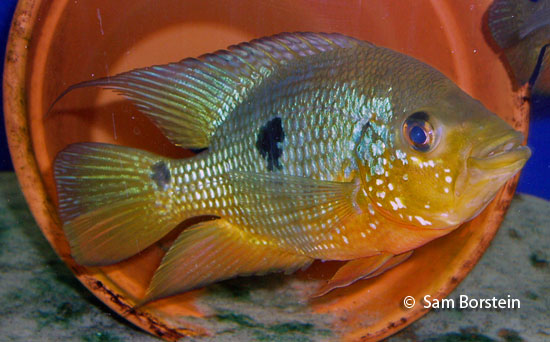Caquetaia spectabilis
(Steindachner, 1875)

Above: A male Caquetaia spectabilis. Photo by Sam Borstein.
Etymology:
Genus- Caquetaia= From Caqueta river which enters into the Amazon.
Species- spectabilis= striking (Latin).
Intro:
Caquetaia spectabilis is a beautiful and large predator. This large protrusible mouthed ambush predator was first typed by Steindachner in 1875. C. spectibilis is one robust fish with a shocking assortment of blue, yellow, orange and green colors and is a must for the predatory cichlid enthusiast.
Distribution:
This fish is found in the Amazon River and its drainages in Brazil. It is an ambush predator and is associated with vegetation near the banks of rivers.
Size, Maturity, and Sexual Dimorphism:
Size: Males- 12 inches, Females- 10 inches
Maturity: 2 inches
Sexual Dimorphism: Males are larger than females and are more colorful. They also have longer pelvic fins and show much intense striping.
Care:
Big fish equals a big amount of waste, and this is true with Caquetaia spectabilis. This fish is not overly aggressive towards other species, but conspecific aggression can be high. A large tank is needed for this fish. A pair can be kept in a 4 foot tank, but I recommend a 6 foot tank. Weekly water changes are a must and so is strong filtration. The fish will do fine in hard or soft water as long as the extremes are avoided. Provide the fish with lots of large flowerpots and drain tiles as hiding spots.
Diet:
Cauetaia spectabilis is an ambush predator and uses its mouth to suck up anything that will fit. In the aquarium this fish readily accepts food. I like feeding large Spectrum and Tetra Cichlid Sticks.
Breeding:
This fish can be difficult to breed. Some people say they have success with spawning them in RO water. I used regular Chicago tap.
The fish pair off relatively young, but I think they take quite a while to mature: a year or two. This fish is definitely a project. The pair will pick a territory and defend it a few days before spawning. Prior to spawning, the color of the fish intensifies. About 400-1,500 eggs are laid depending on age and size of the pair. They are pretty good parents. When my father spawned them, he artificially hatched them, which lead to good results. I on the other hand decided to see if they would defend their spawn, and they did, but I got only about 30 fry. They did move them into a large cave with only one opening, which I thought was interesting.
The fry are easy to raise, but are cannibalistic, so make sure you feed enough. They grow fast.
Conclusion:
This is a spectacular fish. It is beautiful and is a must for South American cichlid enthusiasts. It is drop dead gorgeous and interesting. If you like Red Bay Snooks, you'll enjoy this fish.
